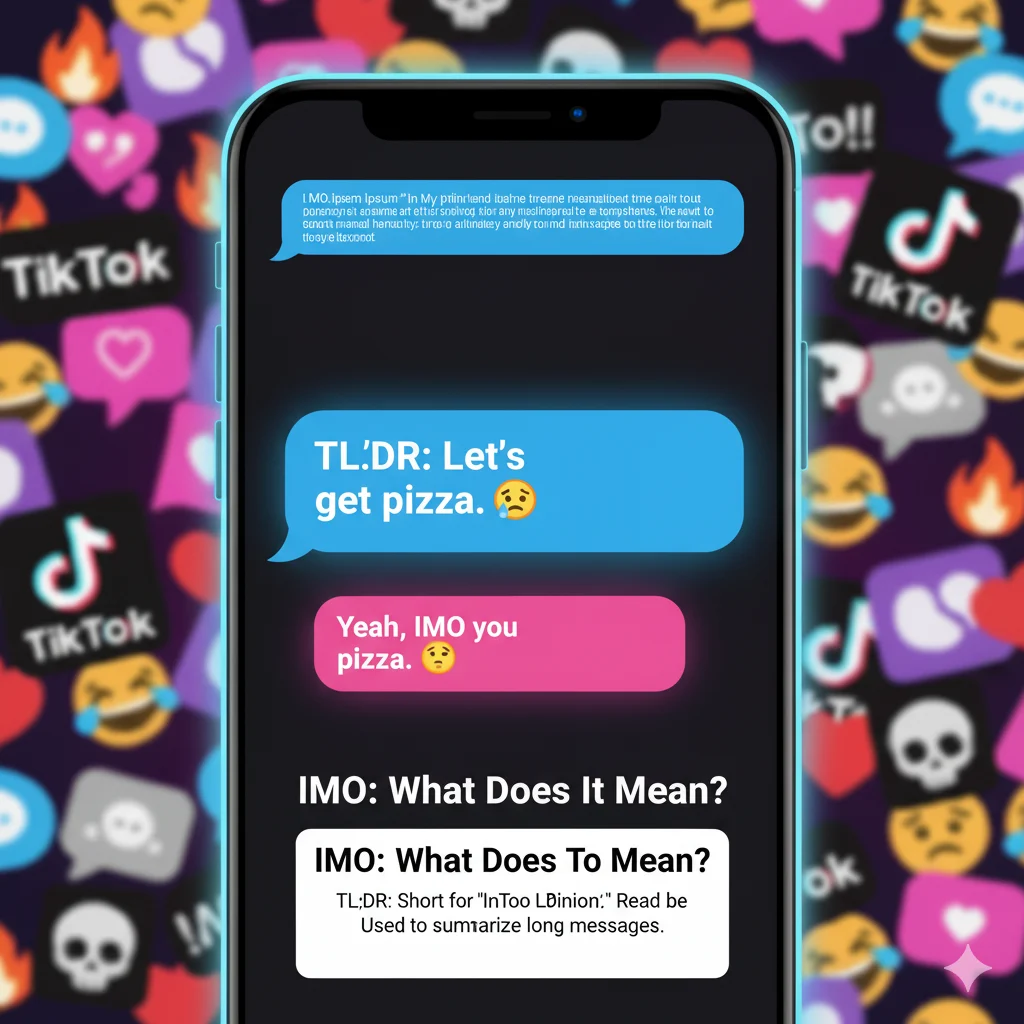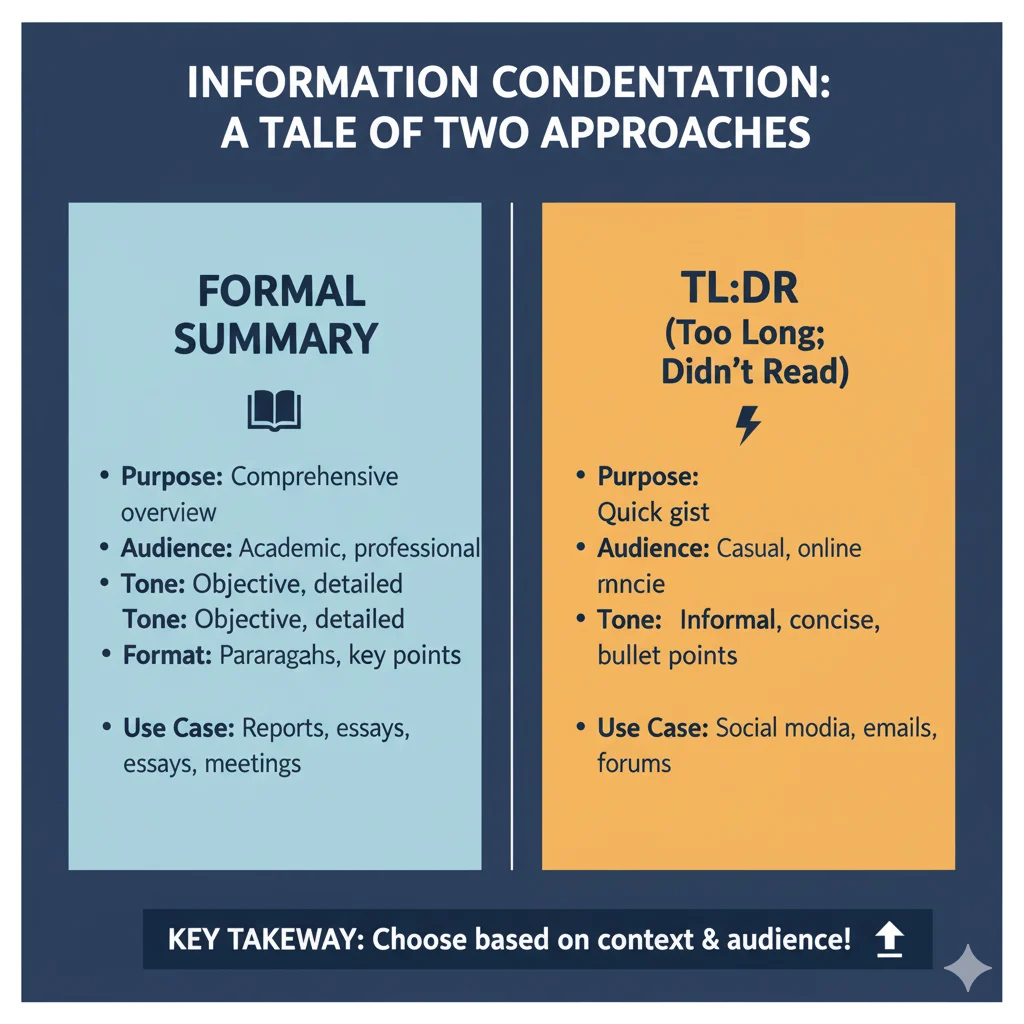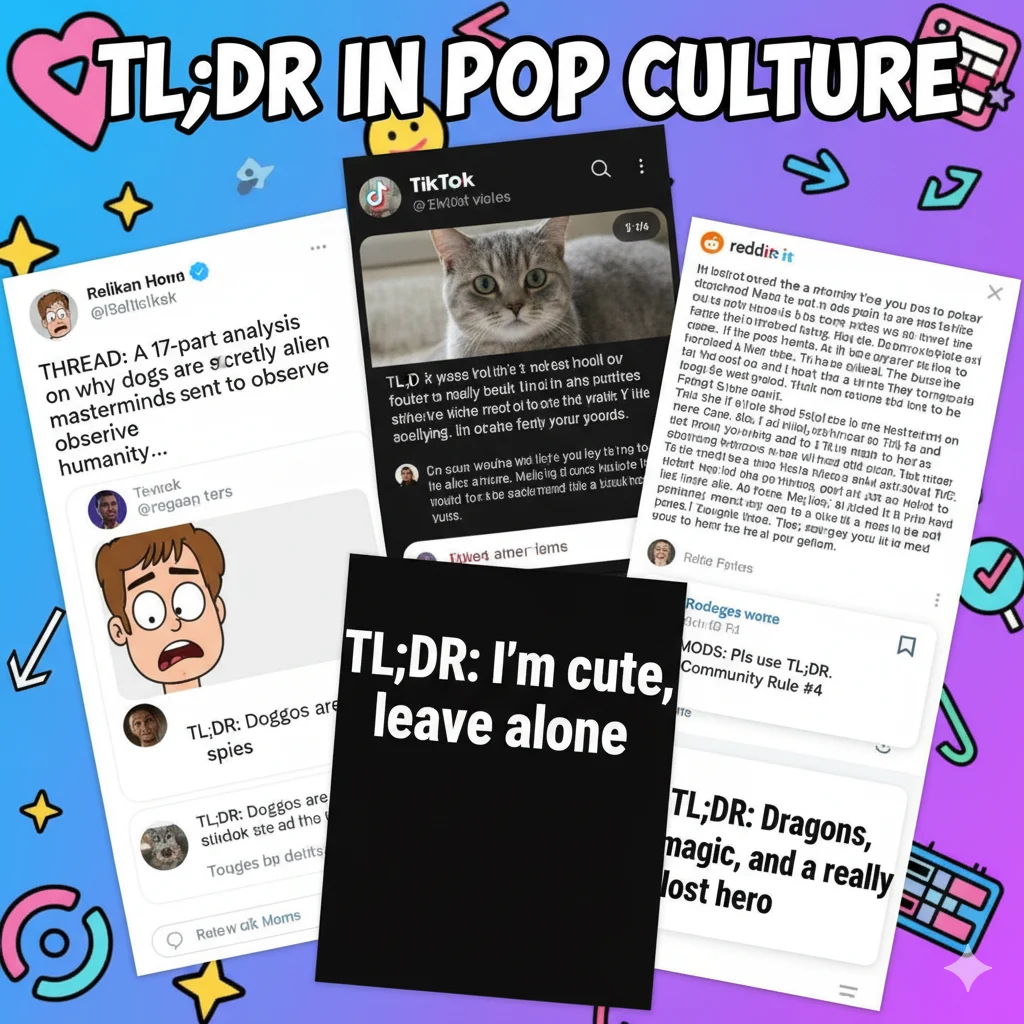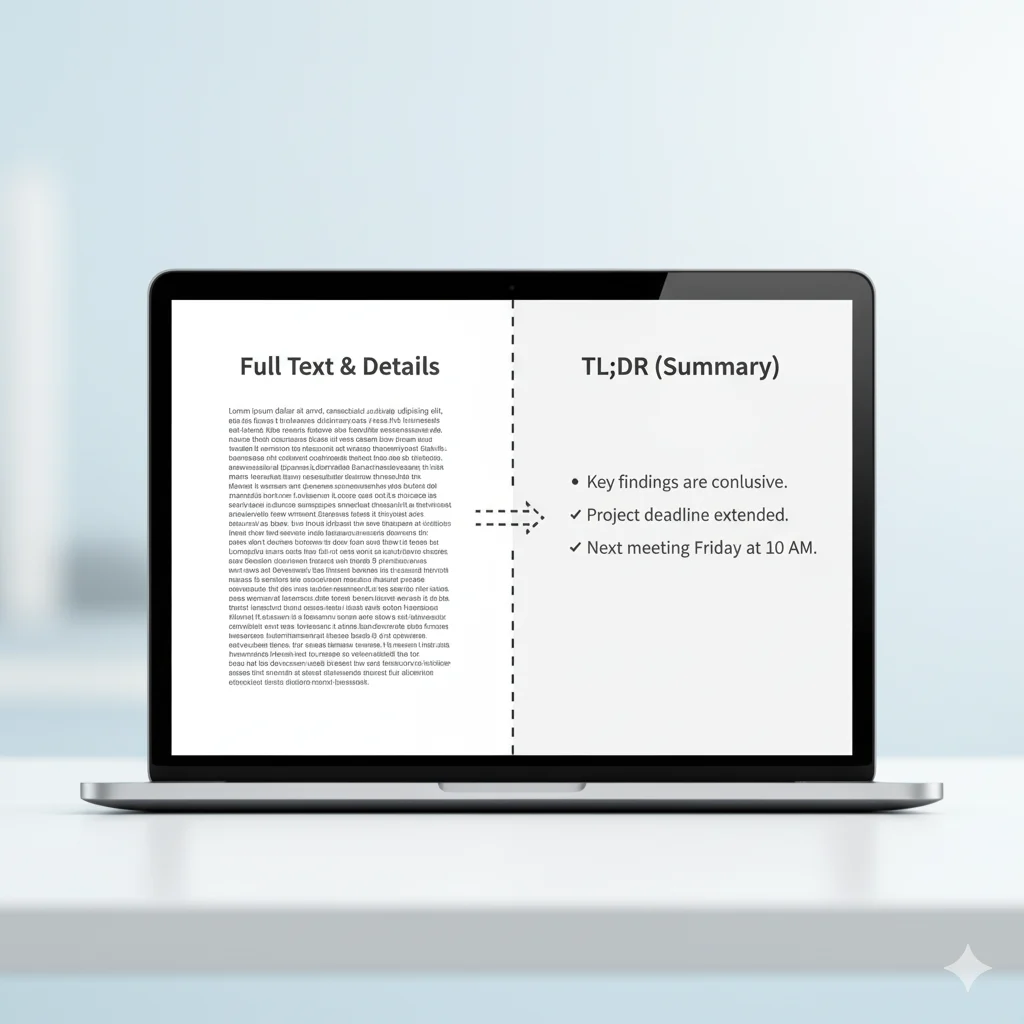TL;DR stands for “Too Long; Didn’t Read.” It’s an internet acronym used to summarize long text or indicate that something is too lengthy to read in full.
People use TL;DR either to summarize what they said (“TL;DR: summary below 👇”) or to admit they skipped reading something long (“TL;DR — that post was huge”).
Let’s dive into what TL;DR means, where it came from, how to use it properly, and why it’s become essential in today’s fast-scrolling internet culture.
🧠 TL;DR Meaning in Texting and Online Conversations
The acronym TL;DR means “Too Long; Didn’t Read.”
It serves two major purposes online:
- To summarize long content briefly.
- To comment that something was too long to read fully.
Examples:
- “TL;DR: The new update fixed most of the bugs.”
- “TL;DR — I skipped the essay; it was too long.”
💡 Quick Tip:
The semicolon (;) in TL;DR separates the two parts: the cause (“Too Long”) and the reaction (“Didn’t Read”).

📜 TL;DR Origin and History
TL;DR began in the early 2000s on forums like Reddit, Something Awful, and 4chan, where users often posted lengthy text walls.
Other users would reply jokingly:
“TL;DR — give me the short version.”
Soon, writers themselves began adding a “TL;DR section” at the end of their posts to summarize key points — showing consideration for readers.
Timeline Snapshot:
| Year | Event | Platform |
|---|---|---|
| Early 2000s | TL;DR appears in online forums | Something Awful, Usenet |
| 2005–2010 | Widespread on Reddit | “TL;DR” summaries in comments |
| 2015+ | Mainstream in memes, tweets, and blogs | Social media & marketing |
| 2020s | Accepted in professional content | Emails, newsletters, workplace chat |
Today, “TL;DR” has evolved into a cultural shorthand for digital attention span — the internet’s way of saying, “just give me the highlights.”

📱 How TL;DR Is Used Online
TL;DR can appear at the beginning or end of a message — depending on how it’s used:
| Placement | Purpose | Example |
|---|---|---|
| At the Beginning | To warn readers it’s short | “TL;DR: The event got canceled.” |
| At the End | To summarize content | “TL;DR: Always back up your files.” |
| In Replies | As commentary | “TL;DR — too long to bother.” |
💡 Fun Fact:
Reddit even uses a “TL;DR bot” to auto-generate short summaries of long posts!

🧾 TL;DR in Modern Communication
In the age of short attention spans and endless scrolling, TL;DR is more relevant than ever.
Common Contexts:
- Texting: “TL;DR, I’m not coming tonight.”
- Emails: “TL;DR: Budget approved, launch Monday.”
- Blogs: “TL;DR summary for readers in a rush.”
- Corporate Slack: “TL;DR: Team meeting rescheduled to Friday.”
💬 It’s basically the digital era’s version of a summary, showing that the sender values efficiency and clarity.

🔍 TL;DR vs. Summary: What’s the Difference?
While both convey condensed information, TL;DR has a casual internet tone, while “summary” is more formal.
| Term | Meaning | Tone | Example |
|---|---|---|---|
| TL;DR | Too long; didn’t read | Casual / Internet slang | “TL;DR: Be kind online.” |
| Summary | Condensed version of info | Formal / Academic | “Summary: Research shows rising trends.” |
💡 Use “TL;DR” for informal writing (posts, comments, DMs), and “Summary” for professional or academic purposes.
⚖️ TL;DR vs. TMI vs. FYI vs. BRB
Here’s how TL;DR compares to other popular abbreviations:
| Acronym | Full Form | Meaning | Use Example |
|---|---|---|---|
| TL;DR | Too Long; Didn’t Read | Condenses or critiques long text | “TL;DR: It’s good but pricey.” |
| TMI | Too Much Information | Oversharing or unnecessary detail | “TMI, bro!” |
| FYI | For Your Information | Sharing a fact or update | “FYI, the report’s due tomorrow.” |
| BRB | Be Right Back | Temporary absence | “BRB, getting coffee.” |
Each abbreviation shapes tone differently — TL;DR signals brevity, while TMI and FYI relate to information overload or updates.
🧠 Why TL;DR Exists: The Psychology Behind It
The internet rewards speed and simplicity — people want bite-sized info they can digest quickly.
TL;DR is a symptom of:
- Shorter attention spans
- Content overload
- The rise of “skim culture”
- Desire for instant answers
Yet, paradoxically, adding a TL;DR summary at the end of a long post often makes readers more likely to read the full content, because it provides a clear entry point.
💬 Examples of TL;DR in Everyday Use
Casual Chat Example:
A: “I wrote this long rant about my exam.”
B: “TL;DR please 😅”
Professional Example:
“TL;DR: The project’s on track. Next steps below.”
Social Media Example:
“TL;DR: You don’t need every productivity app — just consistency.”
Marketing Example:
“TL;DR: Black Friday sale live now — 50% off everything.”
Each use keeps communication concise, efficient, and clear.
📊 When to Use TL;DR (and When Not To)
| ✅ Use TL;DR When | ❌ Avoid TL;DR When |
|---|---|
| Summarizing a long post or email | Writing academic papers |
| Sharing quick takeaways | In official reports |
| Commenting humorously | In resumes or job applications |
| Creating memes or Reddit posts | When clarity requires full detail |
Pro Tip:
In professional writing, you can replace TL;DR with phrases like “In summary,” “Key takeaway,” or “In short.”
🧩 TL;DR in Business and Marketing
Marketers love TL;DR because it works perfectly for capturing attention.
Example:
“TL;DR: 10% off everything today only!”
Modern newsletters (like Morning Brew or TLDR News) even use the acronym in their brand names, signaling concise, high-value summaries.
Why It Works:
- It respects readers’ time.
- It fits mobile screen behavior.
- It matches Gen Z and Millennial communication style.
🌐 TL;DR in Pop Culture and Memes
The acronym TL;DR has also gone beyond text — it’s now a humorous meme concept.
Example memes:
- “TL;DR: I’m right.”
- “TL;DR: Life’s complicated.”
- “TL;DR: Don’t be like me.”
On TikTok and Twitter, creators use TL;DR to caption short takes on long trends, turning it into a punchline for overly detailed situations.
🧮 Common Mistakes with TL;DR
| Mistake | Why It’s Wrong | Correct Use |
|---|---|---|
| Writing “TLDR” without semicolon | Loses original structure | “TL;DR” (with semicolon) |
| Using it mid-sentence | Breaks readability | Start or end only |
| Using it sarcastically in formal writing | Sounds unprofessional | Avoid in reports or proposals |
🧘 TL;DR’s Role in the Age of AI and Information Overload
In a world of AI-generated summaries, short-form videos, and micro-content, TL;DR still stands strong as a human shorthand for clarity.
It’s not just slang — it’s a communication philosophy that values brevity and transparency.
Think of TL;DR as a respect signal: you’re saying, “I know your time matters, so here’s the essence.”
❓ FAQs About TL;DR
1. What does TL;DR stand for?
– It stands for “Too Long; Didn’t Read.”
2. Is TL;DR rude?
– Not necessarily. It depends on tone — when used humorously or helpfully, it’s perfectly fine.
3. Do I need to include a semicolon in TL;DR?
– Yes! The semicolon separates the cause and effect (“Too long; didn’t read”).
4. Can I use TL;DR in emails?
– Yes, but only in casual or internal messages. In formal writing, use “Summary” or “In short.”
5. What’s the opposite of TL;DR?
– “ELI5” (Explain Like I’m 5) — used when you want a simplified explanation of something complex.
🏁 Conclusion
TL;DR stands for “Too Long; Didn’t Read”, and it captures the essence of today’s online communication — fast, efficient, and to the point.
From Reddit comments to professional emails, TL;DR helps summarize big ideas into digestible bites.
In a noisy digital world, it’s not just slang — it’s a mindset of respect for time and attention.
So the next time you’re writing something long, don’t forget the power of a TL;DR — because sometimes, the short version says it best.



